#ModularSoundscapes
Explore tagged Tumblr posts
Text

Part 8 of my series about the modules of Voltage Modular (and part 3 of the “F_Series”, a bundle of modules forged after the legendary DIY modular synth “Formant” - the 1977/78 Elektor project in Voltage Modular) is online now.
youtube
In this part I demonstrate and explain the central switching and gating module F_GENR8 and make it work in a couple of example patches.
Content/Timeline:
00:00 What is the module good for?
01:36 A quick introduction to all functions
02:54 The central clock´s function
04:54 Patch 1: the 8 regular gates and the 4 LFOs
09:33 The “F_modules” universe
10:15 Patch 2: the 4 logic gates and synchronizing events
18:17 The 4 random gates
20:51 Patch 3: random gates plus logic gates (and a funny mistake)
24:42 3 types of random gates
26:39 What´s left to mention
28:00 The End
#Elektor#ElektorFormant#FormantDIY#DIYsynth#ElektorDIYFormantsynth#ModularSynths#modularDIY#MusicCreation#ElectronicMusic#synthHistory#Synthesizers#MusicProduction#Synths#CreativeProcess#MusicTechnology#MusicInnovation#MusicEducation#MusicInspiration#SynthEnthusiast#MusicCommunity#Composer#MusicDiscovery#SynthPatches#SoundArt#MusicPassion#ModularSoundscapes#NewMusic#MusicExploration#MusicLearning#learningmodular
2 notes
·
View notes
Text
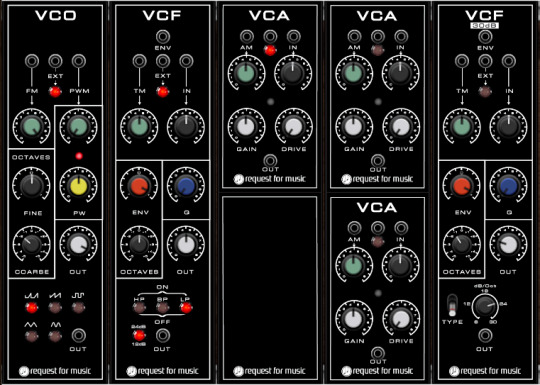
Part 1 of my series about the “F_Series”, a bundle of modules forged after the legendary DIY modular synth “Formant” (the 1977/78 Elektor project) in Voltage Modular is online now:
youtube
Content/Timeline:
00:00 Intro
01:18 A Short History of Modular Synths
06:10 The Original Vintage Modules
06:41 The VCO and its Wave Shapes
11:27 The 3 VCFs
18:56 The LFOs
21:56 The VCA
26:10 The ADSR and the COM Module
26:26 The Noise and Sample And Hold Module
#Elektor#ElektorFormant#FormantDIY#DIYsynth#ElektorDIYFormantsynth#ModularSynths#modularDIY#MusicCreation#ElectronicMusic#synthHistory#Synthesizers#MusicProduction#Synths#CreativeProcess#MusicTechnology#MusicInnovation#MusicEducation#MusicInspiration#SynthEnthusiast#MusicCommunity#Composer#MusicDiscovery#SynthPatches#SoundArt#MusicPassion#ModularSoundscapes#NewMusic#MusicExploration#MusicLearning#learningmodular
2 notes
·
View notes
Text
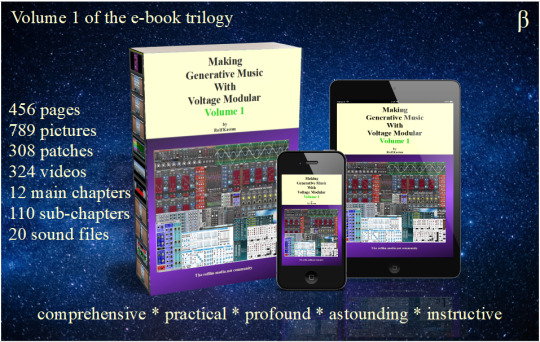
β
What role does chance play in generative music, and are there different types of chance, and if so, how do I generate them with modular synthesizers?
#GenerativeMusic#ModularSynths#MusicCreation#ElectronicMusic#Synthesizers#MusicProduction#Synths#CreativeProcess#MusicTechnology#MusicInnovation#MusicEducation#MusicInspiration#SynthEnthusiast#Composer#SynthPatches#SoundArt#ModularSoundscapes#MusicExploration#MusicLearning#learningmodular#VM#VoltageModular#Playertron#RM_Ware#Weevil#musicandsociety#musicandbiology#musicandphysics#cherryaudio#learningGenerativeMusic
2 notes
·
View notes
Text
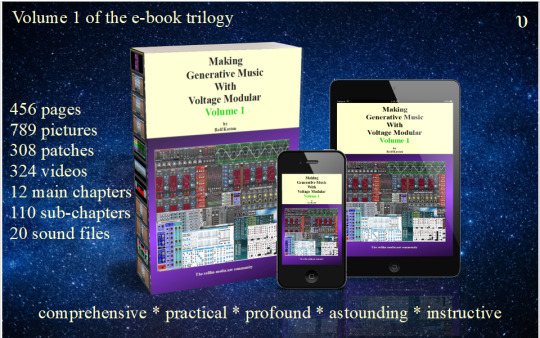
υ
What are the specific problems that I meet when producing generative patches? Get the answer here:
#GenerativeMusic#ModularSynths#MusicCreation#ElectronicMusic#Synthesizers#MusicProduction#Synths#CreativeProcess#MusicTechnology#MusicInnovation#MusicEducation#MusicInspiration#SynthEnthusiast#Composer#SynthPatches#SoundArt#ModularSoundscapes#MusicExploration#MusicLearning#learningmodular#VM#VoltageModular#Playertron#RM_Ware#Weevil#musicandsociety#musicandbiology#musicandphysics#cherryaudio#learningGenerativeMusic
1 note
·
View note
Text
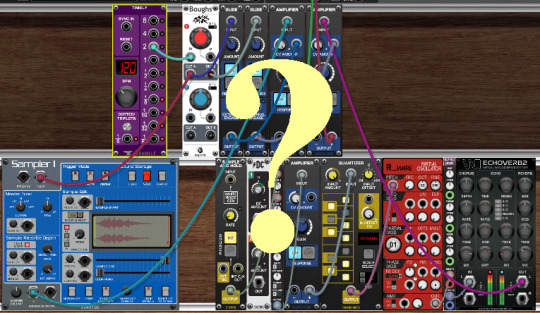
Every real understanding begins with asking the right questions. Here are mine (concerning generative music,):
α
Generative Music transfers some of the responsibility for a musical composition to a “machine” (a system). How? How much? Which ones? Why?
β
What role does chance play in generative music, and are there different types of chance, and if so, how do I generate them with modular synthesizers?
γ
What are the ingredients for generative music, and how do the “kitchen tools” work, the tools I process these ingredients with?
δ
Why are modular synthesizer systems so useful for producing generative music, and how do I get the most out of them?
ε
Does generative music always have to be ambient music? Or slow music? Or comfortable? Or dulcet?
ζ
Do I really need special modules that are suitable for making generative music?
η
What is so special about Voltage Modular that it deserves a whole e-book trilogy only about making generative music with this modular system?
θ
Why is it that generative music helps us understanding Albert Einstein?
ι
How many modules do I need to make generative Music with modular synths?
κ
Does a generative patch always have to run unattendedly?
λ
Can generative music be more or less generative? Is there a kind of degree?
μ
Do “real world” goings on play a role in generative music? Which one?
ν
Is generative music the most or the least human form of music?
ξ
Isn´t every modular synthesizer system potentially or even mainly a machine for creating generative music?
ο
Is generative music a genre, a style, a marketing term or simply a method of producing music?
π
How to prevent John from falling asleep when he is listening to generative music?
ρ
What do I really need to know when I want to make generative music with modular synths?
ς
Why is Voltage Modular one of the best modular synth systems when it comes to making generative music?
σ
Is there such a thing like “pseudo generative music”, and what and how could it possibly be?
τ
Does the term “composing generative music” make any sense?
υ
What are the specific problems that I meet when producing generative patches?
φ
Is producing generative music an alternative to learning music theory?
χ
Is it possible to produce generative dance music (EDM)?
ψ
What are the advantages that Voltage Modular has over other modular synth systems, and are there also disadvantages (which ones)?
ω
Is there an especially close relationship between generative music and modular synths?
ϊ
Where is my own creativity (is there any at all?) when I “provoke” a modular synth to make generative music?
ϋ
Is generative music of any commercial use (or is the invention of the term “generative music” a merely commercial act itself)?
ό
Does it make any sense to perform generative music live (and how may that possibly be done in an interesting way)?
ύ
Is generative music nothing else than musical pseudo-dadaismus?
ώ
What do have generative music and minimal music in common (if there is anything common at all)?
Read the whole article on https://www.dev.rofilm-media.net/node/622
Cheers and peace!
Enjoy your day!
Rolf
#GenerativeMusic#ModularSynths#MusicCreation#ElectronicMusic#Synthesizers#MusicProduction#Synths#CreativeProcess#MusicTechnology#MusicInnovation#MusicEducation#MusicInspiration#SynthEnthusiast#Composer#SynthPatches#SoundArt#ModularSoundscapes#MusicExploration#MusicLearning#learningmodular#VM#VoltageModular#Playertron#RM_Ware#Weevil#musicandsociety#musicandbiology#musicandphysics#cherryaudio#learningGenerativeMusic
1 note
·
View note
Text
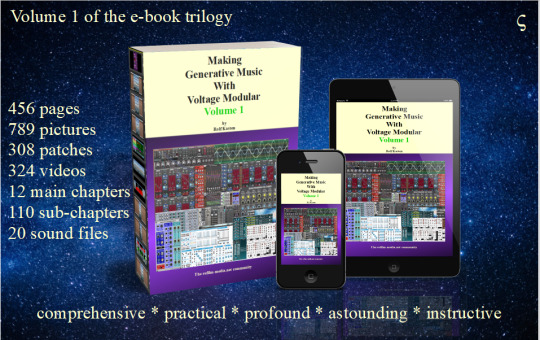
ς
Why is Voltage Modular one of the best modular synth systems when it comes to making generative music?
#GenerativeMusic#ModularSynths#MusicCreation#ElectronicMusic#Synthesizers#MusicProduction#Synths#CreativeProcess#MusicTechnology#MusicInnovation#MusicEducation#MusicInspiration#SynthEnthusiast#Composer#SynthPatches#SoundArt#ModularSoundscapes#MusicExploration#MusicLearning#learningmodular#VM#VoltageModular#Playertron#RM_Ware#Weevil#musicandsociety#musicandbiology#musicandphysics#cherryaudio#learningGenerativeMusic
1 note
·
View note
Text
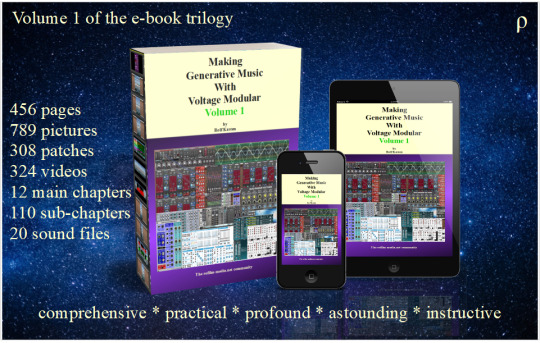
ρ
What do I really need to know when I want to make generative music with modular synths?
#GenerativeMusic#ModularSynths#MusicCreation#ElectronicMusic#Synthesizers#MusicProduction#Synths#CreativeProcess#MusicTechnology#MusicInnovation#MusicEducation#MusicInspiration#SynthEnthusiast#Composer#SynthPatches#SoundArt#ModularSoundscapes#MusicExploration#MusicLearning#learningmodular#VM#VoltageModular#Playertron#RM_Ware#Weevil#musicandsociety#musicandbiology#musicandphysics#cherryaudio#learningGenerativeMusic
1 note
·
View note
Text
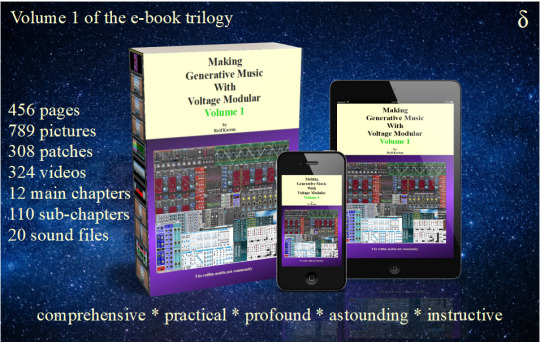
δ
Why are modular synthesizer systems so useful for producing generative music, and how do I get the most out of them?
#GenerativeMusic#ModularSynths#MusicCreation#ElectronicMusic#Synthesizers#MusicProduction#Synths#CreativeProcess#MusicTechnology#MusicInnovation#MusicEducation#MusicInspiration#SynthEnthusiast#Composer#SynthPatches#SoundArt#ModularSoundscapes#MusicExploration#MusicLearning#learningmodular#VM#VoltageModular#Playertron#RM_Ware#Weevil#musicandsociety#musicandbiology#musicandphysics#cherryaudio#learningGenerativeMusic
1 note
·
View note
Text
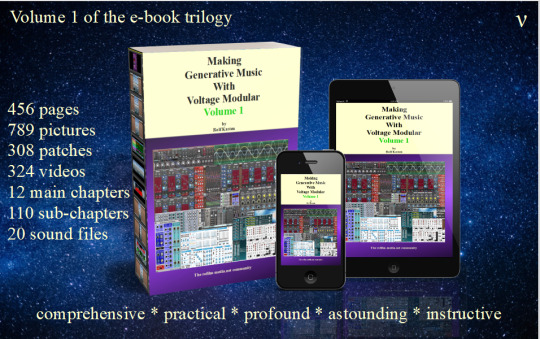
ν
Is generative music the most or the least human form of music?
#GenerativeMusic#ModularSynths#MusicCreation#ElectronicMusic#Synthesizers#MusicProduction#Synths#CreativeProcess#MusicTechnology#MusicInnovation#MusicEducation#MusicInspiration#SynthEnthusiast#Composer#SynthPatches#SoundArt#ModularSoundscapes#MusicExploration#MusicLearning#learningmodular#VM#VoltageModular#Playertron#RM_Ware#Weevil#musicandsociety#musicandbiology#musicandphysics#cherryaudio#learningGenerativeMusic
1 note
·
View note
Text
α
Generative Music transfers some of the responsibility for a musical composition to a “machine” (a system). How? How much? Which ones? Why?
#GenerativeMusic#ModularSynths#MusicCreation#ElectronicMusic#Synthesizers#MusicProduction#Synths#CreativeProcess#MusicTechnology#MusicInnovation#MusicEducation#MusicInspiration#SynthEnthusiast#Composer#SynthPatches#SoundArt#ModularSoundscapes#MusicExploration#MusicLearning#learningmodular#VM#VoltageModular#Playertron#RM_Ware#Weevil#musicandsociety#musicandbiology#musicandphysics#cherryaudio#learningGenerativeMusic
1 note
·
View note
Text
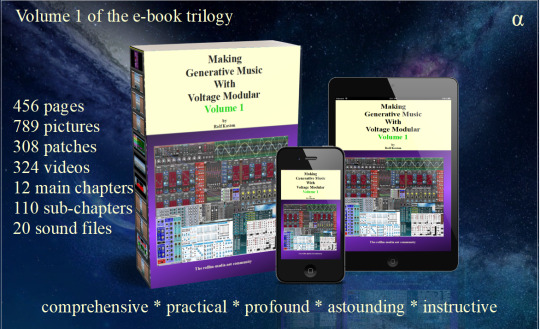
It´s done! The book is available on
(you can even read the first chapter of the book there).
Without a lot of words about “how great” or “how important” this book is, here´s what it contents. Decide yourself!
Cheers and peace!
Rolf
Chapter 0: Some Words About Generative Music And About This Book 006
Chapter 1: Pseudo Randomness And Its Advantages and Disadvantages 008
Chapter 1.1: Using LFOs To Generate Pseudo Randomness 009
Chapter 1.2: Special LFOs And Other Cycle Generating Modules 028
Chapter 1.2.1: R_ware´s “LFO-inator” 028
Chapter 1.2.2: R_ware´s “SplineCurve” 034
Chapter 1.2.3: Looping Envelopes 041
Chapter 1.2.3.1: Mini Envelope VCA Plus by Andrew Macaulay 041
Chapter 1.2.3.2: Super Envelope Generator (Cherry Audio) 050
Chapter 1.2.3.3: AHR Generator (Adroit) 058
Chapter 1.2.3.4: Playertron´s Membrane Function Generator 065
Chapter 1.2.3.5: Benard´s Stochastic SR Envelope 075
Chapter 1.2.3.6: Voltage Modular And the Music Of the Krell 079
Chapter 1.2.3.6.1: Step 1 - Patching a Krell Engine 080
Chapter 1.2.3.6.2: Step 2 – Adding Breakpoints And Modulations 083
Chapter 1.2.3.6.3: Step 3 – The Role Of Sequencers In Krell Patches 091
Chapter 1.2.3.6.4: Step 4 – A Cascade of Krell Engines 093
Chapter 1.2.3.6.5: Step 5 – Modulating Minima And Maxima 095
Chapter 1.2.3.6.6: Step 6 – Polyphonic Krell 099
Chapter 1.2.4: Sequencers 102
Chapter 1.2.4.1: Stochastic CV Sequencers 108
Chapter 1.2.4.1a: Playertron´s Stochastic Note & CV Sequencer 114
Chapter 1.2.4.2: Stochastic Trigger Sequencers 121
Chapter 1.2.5: Shift Registers 125
Chapter 1.2.5.1: DMT´s Shift Register 131
Chapter 1.2.5.1.a: Parrot Machine 132
Chapter 1.2.5.2: Micro Feedback Shift Register
(Synthetic Future x R_Ware) 134
Chapter 1.2.6: Sequential Switches 138
Chapter 1.2.6.1: CHASER by Borkman 146
Chapter 1.2.7: Gray Code Modules 150
Chapter 1.2.8: Samples And Recordings 156
Chapter 1.2.9: Euclidean Sequencers 159
INTERLUDE 1: Randomness, Probability, Stochastic 164
Chapter 2: Different Kinds Of “Real” Randomness 169
Chapter 2.1: Sample & Hold Modules 169
Chapter 2.1.a: Andrew Macaulay´s “Sample/Track And Hold” 172
Chapter 2.1.b: Micro¨Sample And Hold (Synthetic Future x R_Ware) 174
Chapter 2.1.1: Sample Sources for Sample & Hold Modules 175
Chapter 2.1.1.1: Sampling From Regular Wave Shapes 176
Chapter 2.1.1.2: Sampling from Audio 179
Chapter 2.1.1.3: Sampling from Anything 182
Chapter 2.2: Turing Machines 184
Chapter 2.2.1: DMT´s “Turing Universe” 185
Chapter 2.2.2: Playertron´s Turing Algorithm Tape Splicer 191
INTERLUDE 2: Gates And Switches 203
Chapter 2.3: Probability Gates And Random Gates 210
Chapter 2.3.1: HetrickCV´s “Random Gates” 210
Chapter 2.3.2: “Stochastic Trigger Distributor” (Playertron) 212
Chapter 2.3.3: “scrambler” (sys.6 / planet.6) 213
Chapter 2.3.4: “Pulse Train” (Centripidity) 215
Chapter 2.3.5: Bernoulli Gates 227
Chapter 2.3.6: Probability Router 125 (Insomniac Music) 238
Chapter 2.3.7: Real World Triggers And Gates 230
Chapter 2.3.7.1: Triggers And Gates From Field Recordings 230
Chapter 2.3.7.2: Triggers And Gates From Observations 233
Chapter 2.3.7.3: “The Rhythm Of a Day” 234
INTERLUDE 3: Nature´s Paradigm 236
Chapter 3: Modulation Targets And Trigger Targets 248
Chapter 3.1: Pitch 249
Chapter 3.2: Timbre 252
Chapter 3.3: Filters and Equalisers 260
Chapter 3.4: Wave Shapers And Wave Folders 263
Chapter 3.5: Additive Techniques (Partials And More) 271
Chapter 3.6: Voices 281
Chapter 3.7: Rhythm 284
Chapter 3.8: Effects 291
Chapter 3.9: Envelopes 295
Chapter 3.10: Quantizers 297
Chapter 3.11: Grains 299
Chapter 3.12: Sample Player 307
Chapter 3.13: Slew Processors / Limiters 311
Chapter 3.14: Comparators 313
Chapter 4: Compositional Aspects Of Generative Music 316
Chapter 4.1: Basic Compositional Decisions 316
Chapter 4.2: Basic Compositional Techniques 327
Chapter 4.2.1: Contrasting 327
Chapter 4.2.2: Repeating, Modifying And Inverting Relations 330
Chapter 4.2.3: Basic But Exclusively Generative Techniques 335
Chapter 4.3: Specific Compositional Techniques 339
Chapter 4.3.1: Pitch Dependency 339
Chapter 4.3.2: Rhythm 340
Chapter 4.3.3: Tension And Layers 345
Chapter 4.4: Certain Patch Techniques And Examples 347
Chapter 4.4.1: Switching Voices And Layer Parts Of the Patch 347
Chapter 4.4.2: Sculpture Randomness And Setting Borders 353
Chapter 4.4.3: Mixing Regular And Random Elements 356
Chapter 5: Building Blocks Of Generative Patching 363
Chapter 5.1: The Instrumentation Of Envelopes 363
Chapter 5.2: 5 Faces Of Randomness 370
Chapter 5.3: Random Harmonies 381
Chapter 5.3.1: Basic Random Arpeggio Set-Ups 381
Chapter 5.3.2: Certain Modules To Work With Harmonies 384
Chapter 6: Generative Principles In Nature And Society
And Their Musical Reproduction 391
Chapter 6.1: The Physicist´s Tunes 391
Chapter 6.1.1: Heisenberg´s General Pings 391
Chapter 6.1.2: Einstein´s Melody Of the Spheres 393
Chapter 6.1.3: de Broglie´s Electron Concert 393
Chapter 6.1.4: Heisenberg´s Cosmic Pings (plus a fun patch) 398
Chapter 6.1.5: Feynman´s Dance Of the Quarks 403
Chapter 6.2: The Biologist´s Tunes 407
Chapter 6.2.1: The Symphony Of Photosynthesis 407
Chapter 6.2.2: Enzymatic Choirs 410
Chapter 6.3: Society´s Tunes 414
Chapter 6.3.1: The Wailing Shopping Mall 414
Chapter 6.3.2: City Death Tune 417
Chapter 7: Modules Which Are Especially Useful
When Making Generative Music 421
Chapter 7.1: Quadrature VLFO by Cyberwerks Heavy Industries 421
Chapter 7.1.1: Functionality 421
Chapter 7.1.2: Applications 424
Chapter 7.2: “Feigen” by Vult 428
Chapter 7.2.1: Functionality 428
Chapter 7.2.2: Applications 430
Chapter 7.3: “Distributor” by Vulpus Labs 433
Chapter 7.3.1: Functionality 433
Chapter 7.3.2: Applications 434
Chapter 7.4: Jadwiga Single Pole Filter (Playertron) 437
Chapter 7.4.1: Functionality 437
Chapter 7.4.2: Applications 443
Chapter 8: The Bridge to Volume 2:
Certain Patch Ideas And Their Musical Meaning 447
Chapter 8.1: Competing Melodies And the Turn Of the Tide 447
Chapter 8.2: Stream Of Life 449
Chapter 8.3: Immanent Threat 451
Epilogue 453
Appendix A: Your Personal Advantages As a Buyer Of this Book 454
Appendix B: Contact And Social Media 455
Appendix C: Copyright 456
#GenerativeMusic#ModularSynths#MusicCreation#ElectronicMusic#Synthesizers#MusicProduction#Synths#CreativeProcess#MusicTechnology#MusicInnovation#MusicEducation#MusicInspiration#SynthEnthusiast#Composer#SynthPatches#SoundArt#ModularSoundscapes#MusicExploration#MusicLearning#learningmodular#VM#VoltageModular#Playertron#RM_Ware#Weevil#musicandsociety#musicandbiology#musicandphysics#cherryaudio#learningGenerativeMusic
1 note
·
View note